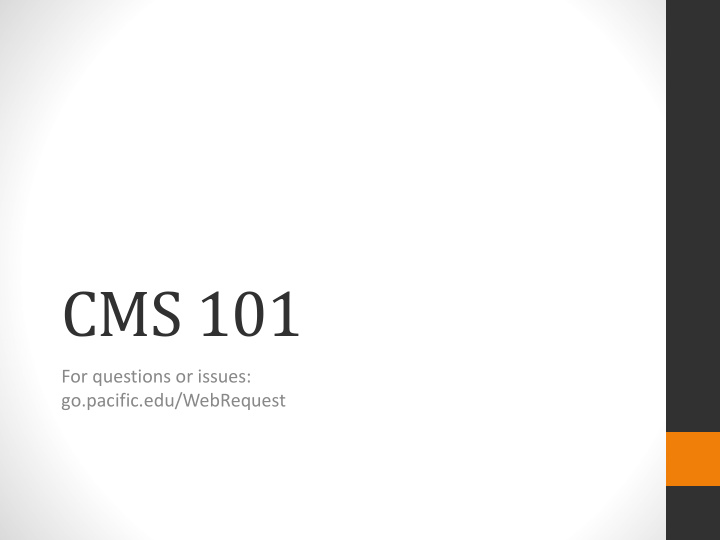



CMS 101 For questions or issues: go.pacific.edu/WebRequest
Overview • Introductions • What is a CMS? • What is Workflow? • Logging into the CMS and overview of CMS interface • Creating a folder • Creating a Detail Page • Text Editing • Inserting Links • Inserting Images • Common CMS Conundrums
What is a CMS • “CMS” stands for Content Management System • Serves as a “middleman” between authors and public site • Allows for easy content creation and manipulation without needing to know HTML, CSS, Java, etc. • Many CMS vendors, Pacific uses Ingeniux CMS • Best browsers: Google Chrome, Mozilla Firefox, Safari (Internet Explorer is glitchy)
What is workflow? • Workflow is the approval process when creating, updating, and publishing a new or existing page in the CMS • “Checkout” a page to be able to edit it, “Check - in” a page when its published • Two types of CMS users: • Authors • Basic user in the CMS • Can create many page types and components • Can edit pages in the CMS • Approvers • All abilities of Authors • Reviews pages advanced to them for approval • Has the ability to publish pages • You move a page through workflow via the button
2-Step Workflow The most common workflow process. Pages that have a 2-step workflow require a “ Send for approval” step before a page can be published. 1 -step workflows allow the page to be published directly without the approval step. Editing State “Checkout” or “Return for “Publish create new page Revisions” Approval State Publish State Content” Approver reviews Page is published page for edits on live site “Send for Approval” “Send for “Reinstate Archiving” page” “Send for Archiving Archiving” Unpublishes page and removes it from live site
Logging into the CMS • http://cms.pacific.edu • Log in with PacificNet username and password • Find the section you will be working in by expanding (+) the pages in the site tree in the left panel. • Create a new page by clicking on an existing page and use the button to select a new page. • Name the page and choose the Detail 2-Step page type (or Detail 1-Step if your section does not require an approver) from the dropdown.
Links Use icon to add links to highlighted text. Types of links: • Internal • Pages with www.pacific.edu • External • Pages outside www.pacific.edu. Best practice is to include “http://” in the web address and to open in new window. • Document • Word, Excel, PDF, etc. Best practice is to open in new window. • Anchor • Links text/image lower in a page to the top of the page (FAQs) • Email
Images • Use the to add an image to the Body Copy • Images must be uploaded before they are inserted into a page • Images must include “Image Description” or “Alt tag” for accessibility compliance • Alignment allows you to align image to the left or right with text wrapping around the image • For good padding, set both Vertical and Horizontal space to 5
Common Conundrums • When I go into Page View or Preview mode, certain pages don’t show up in the left navigation or don’t preview at all. • Make sure that you’ve checked the “Show All Pages” box at the top of your Dashboard. Conversely, if pages or components that have been archived or hidden are displaying, make sure to un-check the “Show All Pages” box.
Common Conundrums • I keep resizing my photos, but no matter what I do, the dimensions keep getting thrown off. • The photo editor in the CMS is not a reliable means of resizing photos; we recommend that you use a program like Photoshop or Picasa, or online photo editing websites like Pixlr.com and Fotor.com, to resize your images before uploading them into the CMS. • I want to jazz up our program’s page; are colorful scripts and creative fonts allowed? • Part of the purpose of a University-wide CMS is to keep a consistent look throughout the university website. There are many ways to customize your program’s page while adhering to the “Pacific Look,” and we are glad to walk you through those options.
Common Conundrums • I need to edit a certain page, but I cannot check it out or advance it in the workflow. What’s going on? • Several things could be going on here: • You sent a page to an Approver for review, in which case you will not be able to edit the page until it is assigned back to you by the reviewer, or until the page is published, at which point you can check it out again. • You have not been given permission to access this page; contact the Office of Communications for further assistance. • The page was not assigned to a workflow when it was created; contact the Office of Communications for further assistance. • Someone else has checked out the page, and it will need to be checked in again before you can advance it through the workflow.
Common Conundrums • I’ve published my page; why isn’t it displaying on the live site? • It can take five to ten minutes for changes to appear on the website. If, after ten minutes, your changes do not appear, please contact the Office of Communications. • John McClimans: jmcclimans@pacific.edu 209.946.2812 • CMS Hotline: ext. 22837 webcomm@pacific.edu • http://go.pacific.edu/cmstraining
Resources http://go.pacific.edu/cmstraining • Component and Page Type Cheat Sheets • Updated documentation from past CMS CMS Helpline – 209.932.2837
Recommend
More recommend